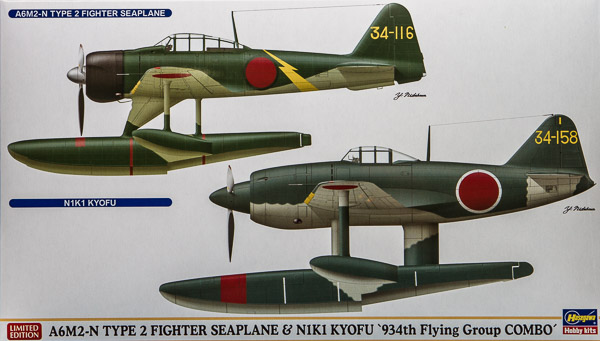
Hasegawa 1/72 A6M2-N Type 2 Fighter Seaplane & N1K1 Kyofu '934th Flying Group Combo'
By Chris Banyai-Riepl
Overview
To perform the role of reconnaissance in the Pacific islands, the Japanese Navy opted to use single-place floatplanes. While a powerful and advanced floatplane was being developed, the Navy decided to convert an existing aircraft to fill the gap. The result was the A6M2-N Type 2, which mated a large centerline float and two outrigger floats to the standard A6M Zero. First flown in December 1941, the A6M-2 flew throughout the war, although by the end of the conflict it was sorely outclassed.
Tasked with building the advanced floatplane fighter, Kawanishi developed their design alongside the land-based N1K1. Unlike the A6M-2 that was a simple conversion, the N1K1 Kyofu featured several differences, including contra-rotating propellers in the prototypes to counteract the torque of the powerful MK4D Kasei engine. The complexity of this system kept it out of the production aircraft, and by the end of the war 96 N1K1 Kyofu aircraft were built.
The Kits
This latest combo kit release from Hasegawa brings a pair of classic mid-90s kits, their A6M2-N Rufe originally released in 1994, and their N1K1 Kyofu that first arrived a year later in 1995. Both come molded in light gray plastic and feature finely recessed panel lines. As these are floatplanes, the two kits both come with dollies to rest on, and each comes with two marking options each, all from the 934th Naval Flying Group at Ambon Island in 1944.
The A6M2-N Rufe
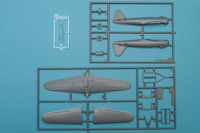 Starting with the A6M2-N, this kit is typical of mid-90s Hasegawa kits with a simple interior. You get a one-piece floor with a rear bulkhead, separate seat, and separate control stick. The instrument panel is also separate and mounts to the underside of the top fuselage insert. There is no raised details at all, and the instruments are provided in decal form. Given that the canopy is heavily framed and molded in a closed format, just the addition of seatbelts would be sufficient here. For those who want to open the canopy, though, you'll want to track down a resin replacement here.
Starting with the A6M2-N, this kit is typical of mid-90s Hasegawa kits with a simple interior. You get a one-piece floor with a rear bulkhead, separate seat, and separate control stick. The instrument panel is also separate and mounts to the underside of the top fuselage insert. There is no raised details at all, and the instruments are provided in decal form. Given that the canopy is heavily framed and molded in a closed format, just the addition of seatbelts would be sufficient here. For those who want to open the canopy, though, you'll want to track down a resin replacement here.
The remaining construction is very straightforward, and will not take long to put together. The fuselage halves are split into halves, with that aforementioned top insert containing the complex curves around the guns. The cowl is separate and molded as mostly one piece, with just a separate scoop and exhausts finishing that off. The engine features both rows of cylinders, while the propeller is made up of individual blades and a two-piece hub.
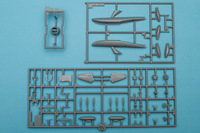 The wings come in three pieces, with separate right and left uppers mating to the one-piece lower wing. The centerline float has a notation to add five grams of weight between the two halves, which will help keep the finished model sitting properly on the dolly. The rear support struts are provided separately as well. For the outrigger struts, the struts are molded in with one half of the float, with the other half separate. Overall, nothing very surprising here, and the kit quickly moves to the painting stage.
The wings come in three pieces, with separate right and left uppers mating to the one-piece lower wing. The centerline float has a notation to add five grams of weight between the two halves, which will help keep the finished model sitting properly on the dolly. The rear support struts are provided separately as well. For the outrigger struts, the struts are molded in with one half of the float, with the other half separate. Overall, nothing very surprising here, and the kit quickly moves to the painting stage.
The N1K1 Kyofu
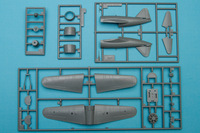 The N1K1 Kyofu kit follows the construction pattern of the A6M2-N, with just a few small differences. The cockpit also has a floor with a separate rear bulkhead, seat, and control stick, with the addition of a front bulkhead and instrument panel complete with a separate gunsight. Like the A6M2-N, the instruments are provided in decal form. Again, since the canopy is molded closed, the addition of seatbelts is really all one would need for a decent interior seen through that framed canopy.
The N1K1 Kyofu kit follows the construction pattern of the A6M2-N, with just a few small differences. The cockpit also has a floor with a separate rear bulkhead, seat, and control stick, with the addition of a front bulkhead and instrument panel complete with a separate gunsight. Like the A6M2-N, the instruments are provided in decal form. Again, since the canopy is molded closed, the addition of seatbelts is really all one would need for a decent interior seen through that framed canopy.
The fuselage is a big round thing on the N1K1 Kyofu, with the cowl separate and molded in three pieces. To keep the forward fuselage at the right cross section, there is a separate insert frame. The cowling only has a front-face of the engine, but the cowl is very tight fitting so not much can be seen once the propeller is in place. The propeller is made up from quite a few pieces, with separate blades, a three-piece hub, and a two-piece insert.
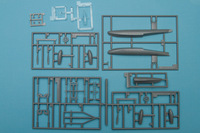 The mid-wing arrangement means that the one-piece lower wing incorporates a large portion of the fuselage underside, while the upper wing halves meet up with those enormous wing root fairings molded into the fuselage halves. Like the A6M2-N, this kit requires weight in the float, but an interesting addition in this kit is a solid plastic insert to provide that. The rest of the float assembly is the same as that in the A6M2-N, for both the main float and outriggers.
The mid-wing arrangement means that the one-piece lower wing incorporates a large portion of the fuselage underside, while the upper wing halves meet up with those enormous wing root fairings molded into the fuselage halves. Like the A6M2-N, this kit requires weight in the float, but an interesting addition in this kit is a solid plastic insert to provide that. The rest of the float assembly is the same as that in the A6M2-N, for both the main float and outriggers.
The Decals
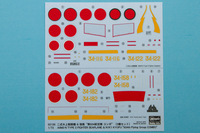 All four marking options across both kits are finished in green over gray, although the specific shades are different due to the different manufacturers. The A6M2-N also has the added feature of a black cowling with a silver spinner, while the N1K1 Kyofu has a camouflaged cowl and a green spinner. As noted earlier, all four options are from the 934th Naval Flying Group seen at Ambon Island in March of 1944, and with one exception, the only difference between the aircraft are the tail numbers. That one exception is the A6M2-N, 34-116, which features a yellow lightning bolt on the rear fuselage. The decal sheet provides some detail markings, including float warning markings.
All four marking options across both kits are finished in green over gray, although the specific shades are different due to the different manufacturers. The A6M2-N also has the added feature of a black cowling with a silver spinner, while the N1K1 Kyofu has a camouflaged cowl and a green spinner. As noted earlier, all four options are from the 934th Naval Flying Group seen at Ambon Island in March of 1944, and with one exception, the only difference between the aircraft are the tail numbers. That one exception is the A6M2-N, 34-116, which features a yellow lightning bolt on the rear fuselage. The decal sheet provides some detail markings, including float warning markings.
Conclusion
These are both nice little kits that will build up quickly out of the box. The interesting markings from the same unit and location makes for an interesting display option, as these two aircraft were quite likely anchored in the same harbor. My thanks to Hasegawa USA for the review sample.
